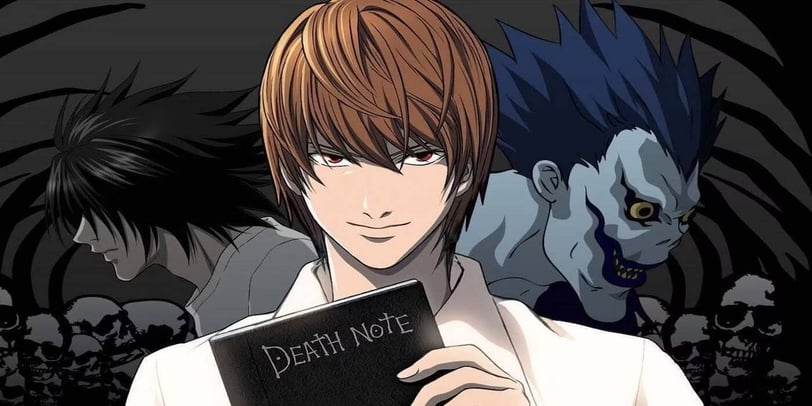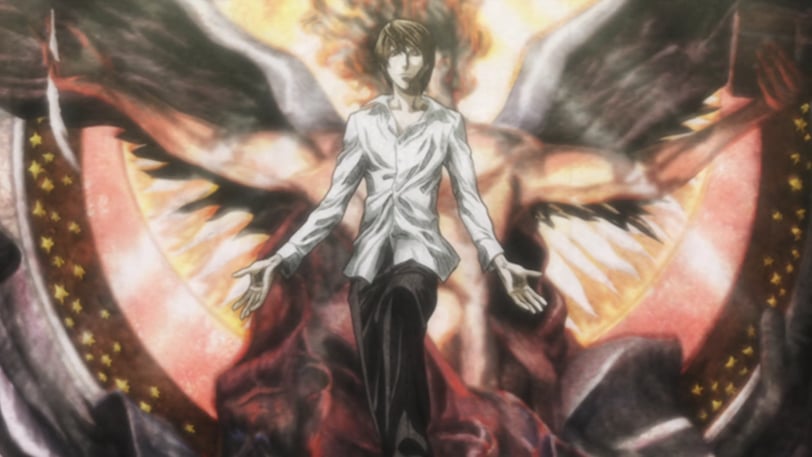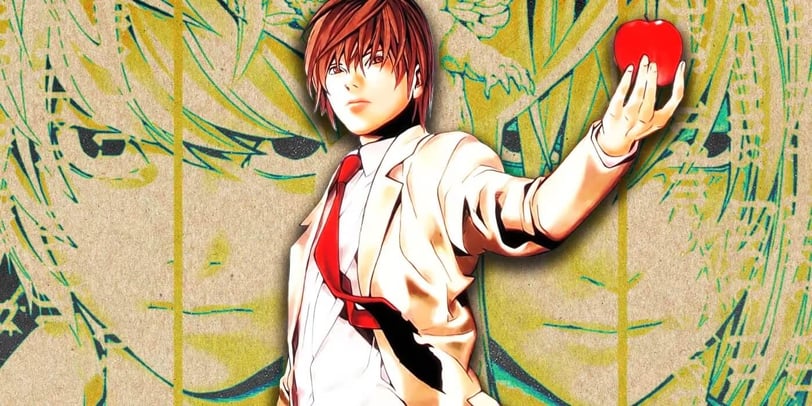10 Mind-Blowing Death Note Theories That Will Change How You See the Anime
Discover 10 mind-blowing Death Note theories that will change how you see the anime! From Light becoming a Shinigami to hidden truths about L, these shocking fan theories will make you rethink everything. Read now!
DEATH NOTE
Anime Fever
2/27/202511 min read


🚨 Spoiler Warning! 🚨
This article contains major spoilers for Death Note. If you haven’t finished the anime or manga, read at your own risk!
Since its release, Death Note has become one of the most iconic and thought-provoking anime of all time. With its intelligent storytelling, psychological battles, and moral dilemmas, the series has captivated fans around the world. The battle between Light Yagami and L is filled with mind games, deception, and unexpected twists, making it a show that keeps viewers on the edge of their seats.
Because of its complex plot and open-ended mysteries, Death Note has sparked countless fan theories over the years. Some theories aim to explain unanswered questions, while others completely change the way we see the story. From the idea that Light becomes a Shinigami to the possibility that L allowed himself to lose, these interpretations add new layers of depth to the anime.
In this article, we’ll explore 10 mind-blowing theories that could completely change your perception of Death Note. Whether you’re a longtime fan or someone revisiting the series, these theories will make you see the story in a whole new light.
Theory #1: Light Yagami Becomes a Shinigami

One of the most intriguing theories among Death Note fans is that Light Yagami becomes a Shinigami after his death. This idea stems from the recap movie Death Note Relight 1: Visions of a God, where an unnamed Shinigami seeks out Ryuk to hear the story of Kira.
Evidence Supporting the Theory
Appearance Similarities: The unnamed Shinigami has a skeletal, humanoid figure and wears a coat reminiscent of the one Light wore on the day of his death. Additionally, it has a red tie wrapped around its head, similar to Light's school uniform tie.
Behavioral Parallels: Like Light, this Shinigami exhibits boredom with the Shinigami Realm and seeks stimulation, mirroring Light's desire for excitement and challenge.
Narrative Role: In Relight 1, the unnamed Shinigami approaches Ryuk, offering him an apple in exchange for the story of Kira. This mirrors the dynamic between Light and Ryuk, suggesting a cyclical relationship.
Counterarguments
Canonical Ambiguity: The original Death Note manga and anime state that humans who use the Death Note are destined for "Mu" (nothingness) after death, with no mention of becoming Shinigami.
Non-Canonical Source: Relight 1 is a recap movie with additional content, but it's not considered part of the main canon. Therefore, interpretations from this material may not reflect the creators' original intentions.
While this theory offers a fascinating perspective on Light's fate, it remains unconfirmed within the official canon. However, the visual and behavioral cues presented in Relight 1 continue to fuel speculation and debate among fans.
Theory #2: L Knew He Would Die and Let It Happen

Many Death Note fans speculate that L anticipated his own demise and chose not to prevent it. This theory suggests that his profound intellect and unwavering commitment to justice led him to accept his fate.
Evidence Supporting the Theory
Foreshadowing Through Symbolism: In a poignant scene, L mentions hearing the "sound of bells," which often symbolizes impending death. This subtle hint suggests his awareness of his approaching end.
Acts of Humility: Shortly before his death, L washes Light's feet, mirroring a biblical act of humility and possibly signifying a farewell gesture, indicating his acceptance of the outcome.
Behavioral Cues: Observations from fans note that L's demeanor becomes increasingly somber, as if he is preparing himself for the inevitable.
Implications of the Theory
If L indeed foresaw his death and allowed it to happen, it underscores his dedication to justice over self-preservation. Recognizing that his death could expose Kira, L might have viewed his sacrifice as a necessary step toward achieving ultimate justice. This perspective adds a profound layer to his character, highlighting his selflessness and strategic foresight.
Theory #3: Near Used the Death Note to Defeat Light

A compelling theory among Death Note enthusiasts posits that Near may have utilized a Death Note to manipulate events, ensuring Light Yagami's downfall. Central to this hypothesis is the idea that Near controlled Teru Mikami, Light's devoted follower, to orchestrate the final confrontation's outcome.
Evidence Supporting the Theory
Matsuda's Suspicion: In the manga's epilogue, Touta Matsuda, a member of the task force, speculates that Near wrote Mikami's name in a Death Note. This act would compel Mikami to act in ways that guaranteed Light's exposure as Kira. Matsuda's theory suggests that Near's intervention led Mikami to bring the real Death Note to the decisive meeting, sealing Light's fate.
Mikami's Mysterious Demise: Following the climactic events, Mikami dies under ambiguous circumstances while in prison. This sudden death raises questions about whether Near manipulated Mikami's actions and subsequently eliminated him to cover any traces of his own use of the Death Note.
Controversies Surrounding the Theory
Moral Implications: If Near did employ a Death Note, it would contradict his established moral stance against its use. Such an action blurs the ethical line between him and Light, challenging the clear dichotomy between justice and villainy presented throughout the series.
Canonical Ambiguity: The creators of Death Note have neither confirmed nor denied this theory, leaving it open to interpretation. This deliberate ambiguity fuels ongoing debates among fans regarding Near's true methods and the ethical ramifications of his potential actions.
While this theory adds a provocative layer to Near's character and the series' conclusion, it remains speculative, inviting readers to ponder the lengths to which one might go in the pursuit of justice.
Theory #4: Misa Amane Was Killed by a Shinigami

A compelling theory among Death Note fans suggests that Misa Amane met her end not by her own hand, but through the intervention of a Shinigami. This perspective challenges the commonly accepted narrative of her suicide following Light Yagami's death.
Exploration of Misa’s Final Scene and Possible Death
In the anime's concluding episode, Misa is depicted standing on the edge of a building, gazing into the distance. This imagery strongly implies a suicidal intent, especially considering her profound grief over Light's demise. The manga further cements this implication, revealing that Misa took her own life on February 14th, a year after Light's death.
Analysis of Her Relationship with the Shinigami
Misa's interactions with Shinigami, particularly Rem, are pivotal throughout the series. Rem harbors a protective affection for Misa, going so far as to sacrifice herself to safeguard Misa's well-being. This deep bond has led some fans to theorize that another Shinigami, perhaps moved by Rem's actions or possessing a personal interest, might have ended Misa's life to spare her prolonged suffering.
Integration of This Theory into the Narrative
While the series does not provide explicit evidence supporting the notion of a Shinigami orchestrating Misa's death, the theory offers an alternative interpretation of her fate. It suggests that the enigmatic and morally ambiguous nature of Shinigami could extend to acts of mercy, adding a nuanced layer to the story's exploration of life, death, and the supernatural forces governing them.
Theory #5: The Real Villain Was Ryuk

A provocative theory among Death Note enthusiasts posits that Ryuk, the Shinigami who introduces the Death Note to the human world, is the true architect of the ensuing chaos, manipulating Light Yagami's actions for his own amusement.
Ryuk as the Mastermind of Chaos
Bored with the monotony of the Shinigami realm, Ryuk deliberately drops the Death Note into the human world, fully aware that it could lead to significant turmoil. His primary motivation is to alleviate his ennui by observing the havoc that ensues when a human wields such power. Throughout the series, Ryuk maintains a detached demeanor, often expressing amusement at the unfolding events. His decision to withhold critical information and his occasional provocations suggest a desire to steer Light's actions subtly, ensuring the continuation of the drama he set in motion.
Comparison with Other Characters
While characters like L, Near, and Misa Amane have clear motivations—be it justice, duty, or love—Ryuk's intentions are more self-serving. Unlike others who actively work to stop or support Kira, Ryuk remains an observer, yet his initial act of introducing the Death Note is the catalyst for all subsequent events. This detachment, combined with his instigation, positions him as the true antagonist who manipulates events from the shadows.
The Neutrality of Shinigami
Shinigami are typically portrayed as neutral entities, indifferent to human affairs. However, Ryuk's actions blur this neutrality. By introducing the Death Note to Light, he directly influences human events, leading to widespread death and moral dilemmas. While he doesn't dictate Light's choices, his facilitation and enjoyment of the resulting chaos suggest a more malevolent role than that of a mere observer.
In essence, this theory reinterprets Ryuk's role from a passive observer to the true villain of the series, whose desire for entertainment leads to catastrophic consequences for humanity.
Theory #6: L and Near Are Related

A prevalent theory among Death Note fans suggests a familial connection between L and Near, extending beyond their association through Wammy's House.
Possible Connections Beyond Wammy's House
While both characters were nurtured at Wammy's House, an orphanage for gifted children, some fans speculate that their bond might be deeper, potentially as relatives. This theory arises from their striking similarities and the initial conceptions of the characters.
Comparison of Physical and Mental Traits
Physical Resemblance: Both L and Near share distinctive features, such as pale skin, dark eyes, and disheveled hair. Their unconventional postures and habits further accentuate their likeness.
Intellectual Parallels: Each exhibits exceptional analytical abilities and a profound aptitude for strategic thinking, often staying several steps ahead of their adversaries.
Clues from Official Material and Creator Interviews
Originally, the creators of Death Note contemplated making L the father of Near and Mello. However, they abandoned this idea, deeming it inconsistent with L's solitary and antisocial nature. This revelation provides insight into the characters' development and their intended relationships.
In summary, while L and Near are not canonically related by blood, their shared traits and backgrounds have fueled fan theories about a deeper connection.
Theory #7: The Death Note Alters the User’s Mind

A compelling theory among Death Note enthusiasts suggests that the Death Note exerts a profound influence on its users' psyches, leading to significant personality changes.
Personality Changes in Light and Other Users
The most prominent example is Light Yagami, who transitions from a high-achieving, morally upright student to a figure consumed by a god complex, adopting the moniker Kira. This drastic transformation raises questions about the Death Note's potential to corrupt its users.
Analysis of the Corrupting Power of the Death Note
The Death Note grants its possessor the power over life and death, a responsibility that can be overwhelming. This immense power may lead users to develop a sense of superiority and detachment from societal norms, as seen in Light's evolution. The allure of playing god can erode one's moral compass, suggesting that the Death Note has an inherently corrupting influence.
Connection to Philosophical and Psychological Themes
This theory delves into themes of absolute power and its psychological ramifications. Philosophically, it echoes Lord Acton's adage that "absolute power corrupts absolutely." Psychologically, the Death Note's influence can be examined through the lens of narcissism and megalomania, where individuals develop an inflated sense of self-importance and a craving for power.
In essence, the Death Note may act as a catalyst, amplifying latent desires and moral ambiguities within its users, leading to profound psychological transformations.
Theory #8: The World in Death Note is a Dystopia


A compelling perspective among Death Note enthusiasts posits that the series portrays a dystopian society, evident in the populace's swift acceptance of Kira's authoritarian rule.
Rapid Acceptance of Kira's Rule
In the narrative, society quickly acquiesces to Kira's judgment, with crime rates plummeting and global conflicts diminishing. This immediate submission suggests a populace willing to forgo personal freedoms for the promise of security, a hallmark of dystopian settings.
Social Critiques and Real-World Parallels
This theory serves as a critique of societal tendencies to embrace authoritarian figures during times of crisis. It mirrors real-world scenarios where fear and uncertainty lead to the erosion of civil liberties in exchange for perceived safety. The series prompts viewers to reflect on the delicate balance between justice and authoritarianism, highlighting how the allure of a crime-free society can overshadow the moral implications of such control.
Impact on the Overall View of the Story
Viewing Death Note through this dystopian lens shifts the narrative from a simple battle between good and evil to a profound commentary on societal vulnerability to authoritarianism. It challenges audiences to consider the ethical ramifications of sacrificing personal freedoms for collective security and the ease with which a society can descend into dystopia under the guise of order.
Theory #9: Soichiro Yagami Knew Light Was Kira

A thought-provoking theory among Death Note fans suggests that Soichiro Yagami, Light's father, harbored suspicions about his son being Kira, despite his outward trust.
Subtle Hints of Suspicion
Throughout the series, Soichiro exhibits unwavering faith in Light's innocence. However, certain actions imply underlying doubts. For instance, when Light volunteers for confinement to prove he isn't Kira, Soichiro supports this decision, indicating a willingness to consider his son's potential guilt. Additionally, during a critical operation, Soichiro acquires the Shinigami Eyes to identify Mello's real name, a move that indirectly tests Light's involvement as Kira.
Analysis of Soichiro's Dialogues and Actions
Soichiro's internal conflict is evident in his dialogues. He once stated, "If Kira is truly evil... then my son is evil." This remark reflects his struggle between paternal love and his duty as a police officer. His decision to confine himself alongside Light further showcases his desperation to uncover the truth, even at personal risk.
Impact on the Father-Son Dynamic
If Soichiro did suspect Light, it adds a layer of tragedy to their relationship. His internal turmoil between familial devotion and moral duty intensifies the narrative's emotional depth, highlighting the personal costs of the pursuit of justice.
Theory #10: Death Note Is an Endless Cycle


A compelling theory among Death Note enthusiasts posits that the phenomenon of Kira is not confined to a single individual but represents an endless cycle of new users emerging to wield the Death Note.
Kira as a Concept Beyond an Individual
In the series, Kira becomes a symbol of absolute justice, with various individuals adopting the mantle over time. This suggests that Kira transcends Light Yagami, embodying a broader societal archetype where the allure of the Death Note perpetually entices new users to impose their sense of justice. This perspective is explored in discussions about Kira's conceptual nature.
Connection to the Death Note’s Legacy
The Death Note's existence inherently invites a cycle of use and consequence. Each new user, driven by personal motives, contributes to the ongoing legacy of Kira. This cyclical pattern reflects on themes of power, morality, and the human condition, suggesting that as long as the Death Note exists, the emergence of a Kira-like figure is inevitable.
This theory reframes the narrative, highlighting the Death Note as a catalyst for an unending loop of moral dilemmas and societal impact.
Conclusion
Throughout Death Note, countless hidden details and unanswered questions have led fans to develop intriguing theories that reshape how we view the story. From the idea that Light becomes a Shinigami to the notion that Kira is an endless cycle, these theories provide new layers of depth to an already complex narrative.
Each theory challenges our perception of key characters like L, Near, Misa, and Ryuk, making us reconsider their true motives and fates. Whether it’s the moral corruption caused by the Death Note or the possibility that Soichiro suspected Light, these ideas expand the story beyond its original interpretation.
In the end, Death Note remains a masterpiece because of its ambiguity and philosophical depth. These theories remind us that great stories never truly end—they continue to evolve in the minds of fans, inspiring endless discussion and new perspectives.
Read Also: The 6 Hidden Messages in Death Note You Probably Missed
Read Also: Is Death Note Based on a True Story? The Dark Inspirations Behind the Anime
Read Also: L vs. Light: Who Was the Real Genius in Death Note?
